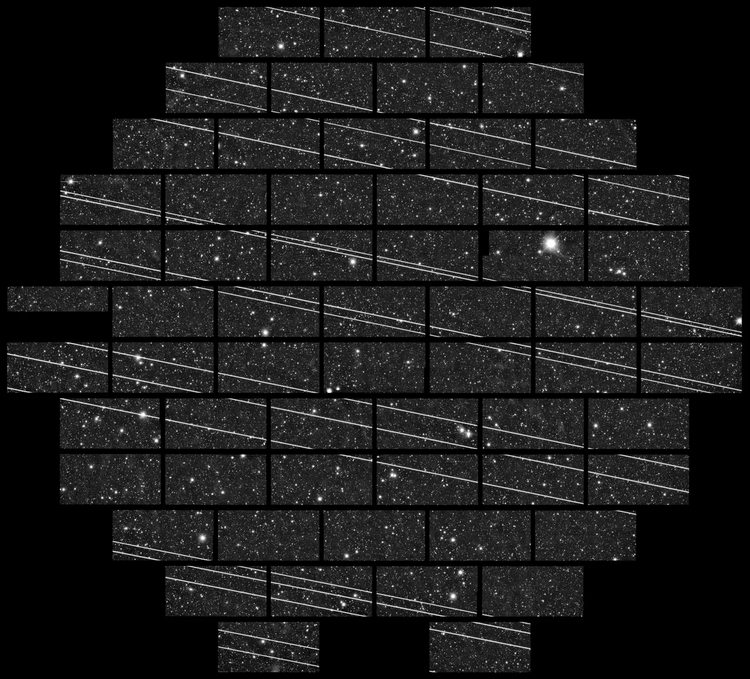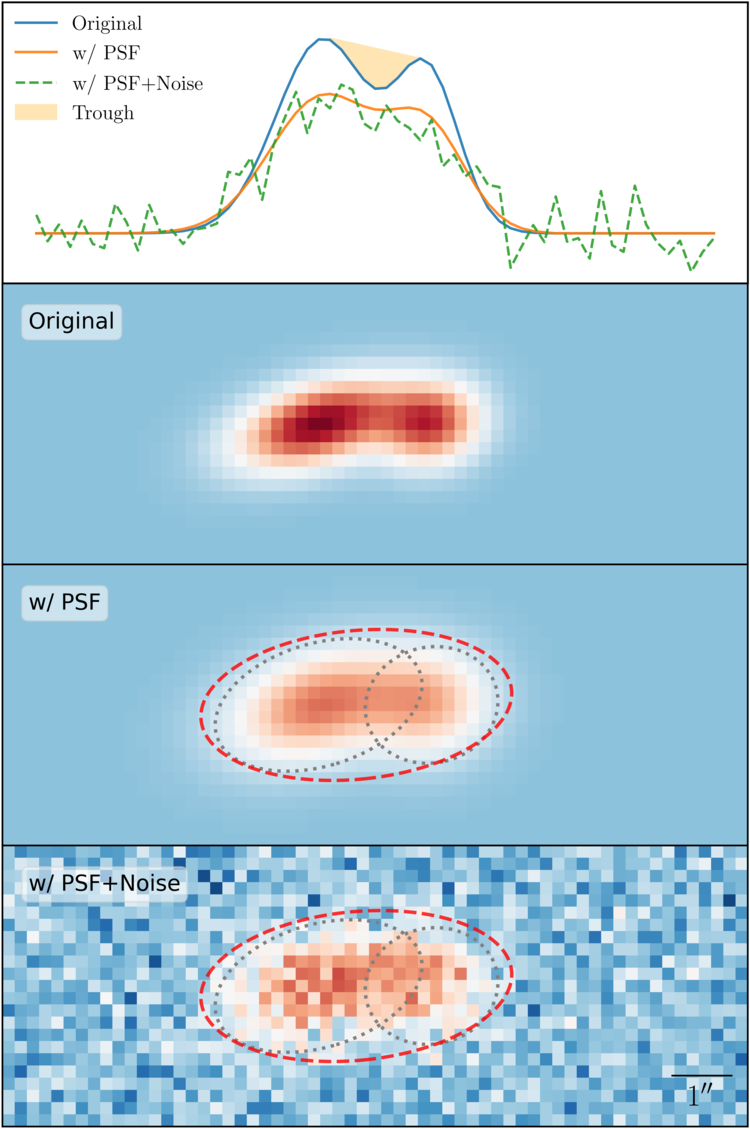
Time-lapse image showing the passage of a Starlink satellite cluster (bright streaks) through a telescope’s field of view at the Cerro Tololo Inter-American Observatory in Chile in November 2019.
Impact of LEO Satellite Constellations on Weak Gravitational Lensing Studies
In collaboration with: Adam Snyder, Tony Tyson
The rapid deployment of low-Earth orbit satellite mega-constellations, such as SpaceX’s Starlink, is introducing new challenges for ground-based astronomy. As these satellites traverse the night sky, they leave bright trails across images, contaminating data and introducing correlated noise. For weak gravitational lensing studies, which rely on detecting subtle distortions in galaxy shapes to map dark matter, these streaks pose a potential source of systematic bias. Understanding their impact is crucial as the Legacy Survey of Space and Time (LSST) prepares to collect an unprecedented volume of cosmological data.
Although satellite streaks can be removed from affected frames, residual artifacts may still appear as lines of faint, “bogus” galaxies. The degree of impact depends on factors such as detection thresholds, the number of exposures, the density of satellites in the dataset, and their brightness. Real images, such as those from HSC and JWST observations of the Hubble COSMOS field, where Starlink streaks are visible in ground-based images but absent in space-based images, provide a unique opportunity to test mitigation strategies for ground-based observations. However, as satellite numbers continue to grow, a key question remains: “How much will these artifacts impact the reliability of LSST’s cosmological findings?” To quantify these effects, I integrate satellite trail models into large-scale cosmological simulations, enabling a controlled study of their influence on cosmic shear analyses. By systematically varying satellite properties and observing conditions, this approach provides a robust framework for evaluating how contamination from satellite constellations may bias weak lensing science and the accuracy of LSST’s cosmological constraints.

Synthetic images of two overlapping galaxies (bottom three panels) simulated with GalSim, alongside their surface brightness profiles (top panel), illustrating detection challenges in blended profiles. The middle panels are noise-free, while the bottom includes Poisson noise from galaxy flux and sky level. Grey dotted ellipses show individual galaxy shapes after PSF convolution, while the red dashed ellipse represents the combined shape.
Overlapping Galaxies Complicate Photometric Redshift Estimation in Crowded Fields
In collaboration with: HyeYun Park, Imran Hasan, Bela Abolfathi, Samuel Schmidt
As next-generation sky surveys such as the Legacy Survey of Space and Time (LSST) push deeper into the universe, galaxy blending emerges as a formidable challenge for photometric measurements. In crowded fields, overlapping sources contaminate each other’s light, distorting colors and introducing biases into photometric redshift (photo-$z$) estimates, the results of a technique that infers galaxy distances from broad-band photometry rather than spectroscopy.
At LSST depths, most galaxies will overlap to some extent, introducing systematic errors into cosmological studies that rely on precise distance measurements. Highly blended galaxies can be misidentified as single objects, shifting their inferred redshifts and distorting tomographic binning—a crucial step in weak lensing and large-scale structure analyses. These “unrecognized” blends, as indicated by simulations, skew galaxy counts and lead to inaccuracies in both clustering and weak lensing measurements. This problem is made worse by atmospheric blurring in ground-based observations, which causes galaxies appearing near each other to smear together, further complicating their separation.
Deblending algorithms attempt to untangle overlapping sources, but current methods struggle with complex blends. Traditional deblenders work band-by-band, assuming symmetric galaxy shapes, which often leads to incorrect flux assignments. More advanced techniques, such as matrix factorization-based deblenders, leverage multi-band information to better separate sources, yet they still require refinement to meet LSST’s stringent science requirements.
To fully harness LSST’s potential, blending-aware photo-$z$ models must be incorporated into cosmological analyses. Our work provides insights into how blending affects redshift estimation and offers a pathway toward improved deblending techniques, ensuring more reliable measurements for the next generation of astronomical surveys.
